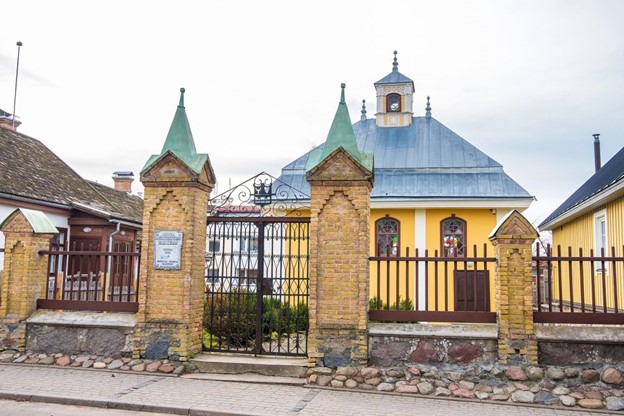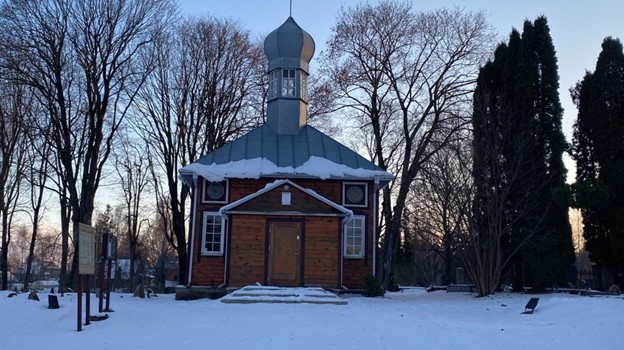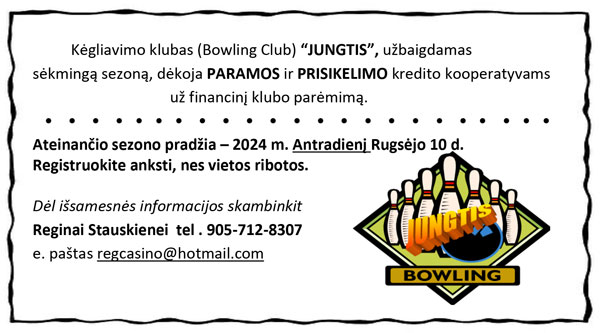
The website Emerging Europe recently published an article by Devin Haas about Lithuania’s wooden mosques and synagogues. He notes that the country’s multi-faith heritage has produced some beautiful wooden houses of worship which, after decades of disuse, are finally being restored.
The village of Nemėžis, fifteen minutes from Vilnius, is home to one of just four operating mosques in Lithuania – and one of the last wooden mosques in all of Europe. Nemėžis has been home to a community of Lipka Tatars since 1397. Vytautas, the ruler of the Grand Duchy of Lithuania at the time, captured Turkic-speaking Tatars during his fight against the Golden Horde and settled many of the prisoners of war across what is now Lithuania, Poland, and Belarus. While many of the Tatars adopted the local languages, their Islamic faith endured.
Wood has been – and in some rural areas of Lithuania, remains – the building material of choice in the densely forested country, and Tatars built their mosques of wood. An older wooden mosque was built in Nemėžis in 1684 but burned down and was replaced by the current mosque in 1909. During the Soviet period, like all houses of worship it was forbidden to be used for prayer and was converted into a museum. Others were used as warehouses. In 1993, prayer resumed and the community of several hundred Muslims in Nemėžis continue to use it for prayer and its grounds for community events and burials. Other wooden Tatar mosques can be found in the Lithuanian villages of Raižiai and Keturiasdešimt Totorių, as well as in Kruszyniany and Bohoniki in Poland and Novogrudok and Iwye in Belarus.
 At the same time as Vytautas settled Muslim Tatars in Lithuania, he also settled Turkic-speaking Karaite Jews known as Karaims around Vilnius as well – mostly in the town of Trakai, where the construction of a large castle was underway.
At the same time as Vytautas settled Muslim Tatars in Lithuania, he also settled Turkic-speaking Karaite Jews known as Karaims around Vilnius as well – mostly in the town of Trakai, where the construction of a large castle was underway.
While the vast majority of Jews adhere to Rabbinic Judaism, which accepts both the Written Torah (Tanakh) and the Oral Torah (the Talmud and Midrash), Karaite Jews do not believe the Oral Torah is binding. Karaite Jews use kenesas – similar to Rabbinical synagogues – for worship, and the Karaims built a wooden kenesa in Trakai.
Similar to how Yiddish is a Germanic language with Hebrew influences and script, the Karaim language is Turkic with Hebrew influences and script. Haas explains that there are three main dialects of Karaim, and one of them is unique to the Trakai-Vilnius area. Today, however, the Karaim language is endangered and has only a few dozen speakers. Luckily, tourism to see the castle in Trakai has increased interest in the town’s Karaim community, and cultural tourism has facilitated new efforts to preserve Karaim culture and language. Besides seeing the Trakai kenesa, tourists can also try Karaim pastries and dishes at the restaurant Kybynlar.
Before World War II, Vilnius – known as Vilne in Yiddish – was 40 to 45 percent Jewish, home to both Rabbinic and Karaite Jews. Vilnius was known “The Jerusalem of the North”. It was home to 110 synagogues and prayer houses, six daily Jewish newspapers, and many Yiddish theatre companies. Jews from around the world travelled to study in its yeshivas. Many of pre-war Lithuania’s roughly 220,000 Jews lived outside of Vilnius, and many rabbinic Jews built grand wooden synagogues with intricate wooden carvings and paintings inside. There were once over 200 wooden synagogues across Lithuania and neighbouring countries.
The Nazis destroyed virtually all of these, burning many, and wiped out a long, beautiful architectural tradition. Haas writes that, as they had done in Tsarist Russia, Karaites succeeded in convincing the Nazi authorities that they were different enough from Rabbinic Jews to be exempt from anti-Semitic policies. Still, solidarity between Karaite and Rabbinic communities remained; Ashkenazi rabbis told Nazi interrogators that Karaites were not Jews to save them from persecution and many Karaites risked their lives sheltering Rabbinic Jews during the Holocaust. Most of Lithuania’s Jews were killed in the Holocaust. Jewish art and culture were also destroyed; only one of Vilnius’ 110 synagogues survived.
The Lithuanian government is taking welcome action to ensure that the 14 surviving wooden synagogues do not fall into disrepair. The only wooden synagogues to survive the Nazis’ genocide were small, indistinct, and in remote villages. They were used for storage in Soviet times and, since there are no permanent Jewish communities left there to maintain them, many rotted away or burned down.
Restoration funded by the Lithuanian Culture Ministry has begun on small wooden synagogues in the villages of Alanta and Kurkliai. Centuries-old wooden synagogues Pakruojis and Žiežmariai are now completely restored and are open for visitors interested in getting a rare glimpse at a once-widespread form of Jewish art.






























